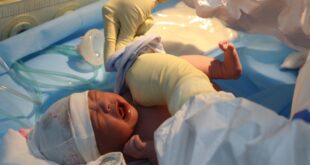Bệnh múa giật
[Có bạn nào đã nghe đến bệnh múa giật chưa?]
Là hậu quả từ một đột biến trong gen huntingtin (HTT) (trên nhiễm sắc thể 4), gây ra sự lặp lại bất thường của chuỗi DNA CAG, mã này mã hóa cho amino acid glutamine. Sản phẩm gen – một protein lớn gọi là huntingtin, có một dải rộng dư lượng polyglutamine, tích tụ trong nơ-ron và gây bệnh thông qua các cơ chế còn chưa rõ. CAG càng lặp lại nhiều lần, bệnh càng xuất hiện sớm hơn và biểu hiện càng nặng hơn (kiểu hình). Số lần lặp lại CAG có thể tăng lên với các thế hệ kế tiếp khi người cha truyền đột biến và theo thời gian, có thể dẫn đến các kiểu hình ngày càng nghiêm trọng trong một gia đình (gọi là dự đoán).
Đây là tình trạng mà cơ thể gặp phải những rối loạn vận động và có những chuyển động không thể đoán được. Ngoài ra, Huntington cũng dẫn đến những rối loạn về mặt tâm lý hay nhận thức của người bệnh.
Bệnh thường gặp ở 3 loại:
Phát âm hoặc nuốt gặp khó khăn.
Vận động của mắt chậm hơn hoặc có sự bất thường.
Tư thế và khả năng giữ thăng bằng gặp vấn đề bất thường.
Vận động quằn quại hay co giật không tự chủ
Trầm cảm
Rối loạn ám ảnh cưỡng chế
Rối loạn lưỡng cực
Hưng cảm
Trong đó trầm cảm là một trong những bệnh lý phổ biến của bệnh múa giật Huntington này.
Những triệu chứng này dẫn đến việc bệnh nhân có ý tưởng tự sát và tự sát, điều này phổ biến hơn ở những bệnh nhân mắc bệnh Huntington so với dân số nói chung.
Khả năng nhận thức hành vi của bản thân suy giảm.
Quá trình suy nghĩ và diễn đạt suy nghĩ chậm chạp, khó khăn.
Khả năng tiếp thu thông tin mới gặp khó khăn.
Thiếu sự linh hoạt.
Bác sĩ sẽ tiến hành khám tổng quát cơ thể, thăm khám tâm – thần kinh và xem xét đến tiền sử bệnh của gia đình.
Cụ thể, quá trình thăm khám chẩn đoán bao gồm các bước:
Thăm khám thần kinh: Đưa ra một số câu hỏi có liên quan và xem xét câu trả lời của người bệnh.
Kiểm tra các triệu chứng vận động, cảm giác và tâm thần.
Xét nghiệm tâm thần kinh.
Đánh giá tâm thần của người bệnh như hành vi, trạng thái cảm xúc, kỹ năng ứng phó,…
Xét nghiệm hình ảnh đánh giá chức năng não bộ như MRI, CT scan,…
Xét nghiệm và tư vấn di truyền
Xét nghiệm tiên đoán di truyền.
————————————————————————
[Has anyone heard of chorea disease?]
It is a consequence of one mutation in the huntingtin (HTT) gene (on chromosome 4), causing an unusual repetition of DNA sequence CAG, this codon encodes for amino acid glutamine. Gene product – a large protein called huntingtin, which has a wide range of polyglutamine residues, accumulated in neurons and causes disease through unknown mechanisms. The more CAG is repeated, the sooner the disease appears and the more severe the manifestation (phenotype). The amount of CAG repetitions can increase with successive generations as the father passes on the mutation and, over time, can lead to increasingly severe phenotypes in a family (predisposition). This is the condition in which the body experiences movement disorder and unpredictable movement. Besides that, Huntington’s disease can also lead to psychological or cognitive disturbances in the patient.
The diseases are often seen in 3 types:
Pronunciation or swallowing difficulties.
Movements of eyes are slower or unusual.
Posture and balancing ability problems.
Writhing movements or involuntary convulsions.
Depression.
Obsessive-Compulsive Disorder.
Bipolar disorder.
Mania.
Depression is one of the common pathologies of Huntington’s chorea. These symptoms lead to patients having suicidal ideas and suicide, which is more common in patients with Huntington’s disease than in the general population.
Decrease self-perception.
The process of thinking and expressing is slow and difficult.
Difficulty absorbing new information.
Lack flexibility.
The doctor will perform a general physical examination, neuropsychological examination, and consideration of family medical history.
In particular, the diagnostic examination process includes the following steps:
Neurological examination: ask some relevant questions and examine the patients’ answers.
Check for motor, sensory, and psychiatric symptoms.
Neuropsychological examination.
Psychiatric assessment of the patient such as behavior, emotional state, coping skills,…
Examine brain function assessment pictures such as MRI, CT scan,…
Examine and genetic counseling.
Genetic predictive examination.
![[chia sẻ]Bệnh múa giật Có thể là hình minh họa](https://scontent.fdad3-5.fna.fbcdn.net/v/t39.30808-6/329032375_1234713127188629_6017391025018448604_n.jpg?stp=dst-jpg_p843x403&_nc_cat=102&ccb=1-7&_nc_sid=5cd70e&_nc_ohc=Y-W-CitS5MgAX_ybnIj&_nc_ht=scontent.fdad3-5.fna&oh=00_AfBrm4yODPfXHgxIWRsmlikEMbuG9YkCBPh7Qj1WBhyBOw&oe=641A65E7)
Tác giả: Nhóm Meddictionary
Link bài viết: [https://www.facebook.com/groups/diendanykhoa.vn/permalink/1591526707959948/?mibextid=Nif5oz]
Xin cảm ơn nhóm Meddtictionary đã đồng ý đăng bài lên Diễn đàn Y Khoa!
Advertisement
 Y khoa Diễn đàn Y khoa, y tế sức khoẻ, kiến thức lâm sàng, chẩn đoán và điều trị, phác đồ, diễn đàn y khoa, hệ sinh thái y khoa online, mới nhất và đáng tin cậy.
Y khoa Diễn đàn Y khoa, y tế sức khoẻ, kiến thức lâm sàng, chẩn đoán và điều trị, phác đồ, diễn đàn y khoa, hệ sinh thái y khoa online, mới nhất và đáng tin cậy.






